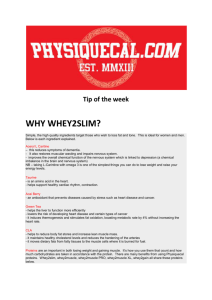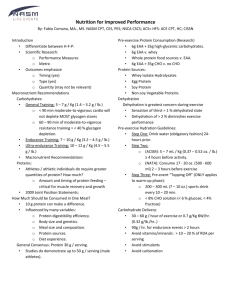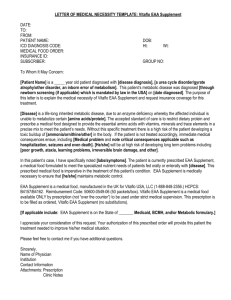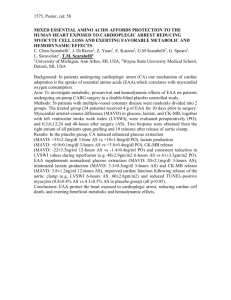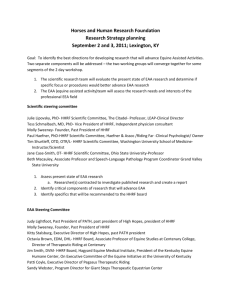Protein Supplementation
advertisement
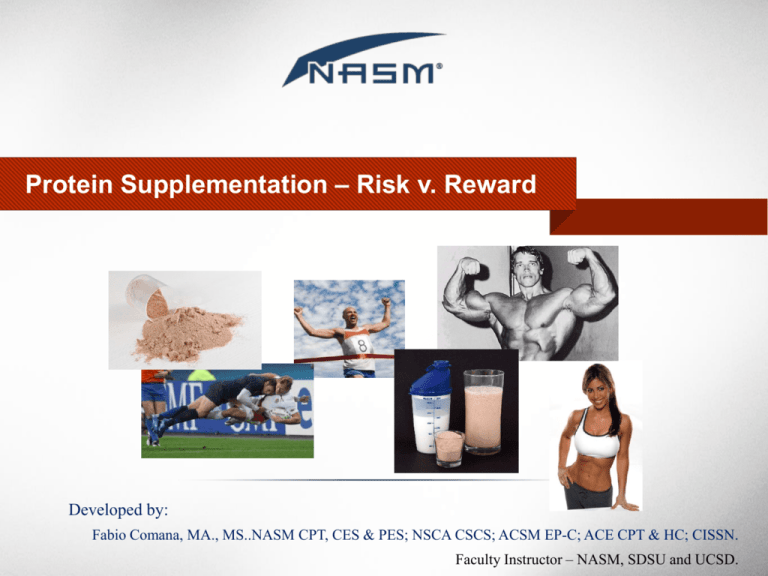
Protein Supplementation – Risk v. Reward Developed by: Fabio Comana, MA., MS..NASM CPT, CES & PES; NSCA CSCS; ACSM EP-C; ACE CPT & HC; CISSN. Faculty Instructor – NASM, SDSU and UCSD. Trends Protein Interest Growth and Sales The Market • Mainstream retailers flocking to protein (bedrock of sports nutrition) – movement from niche-markets (e.g., gyms, supplement stores) to mass-market outlets (retailers even investing in private-label varieties). • Milk-based #1; soy = limited reach; pea/rice/hemp emerging as plant-based leaders. US Consumer Health (2014) - $206 Billion Vitamins & Dietary Supplements (2014) - $84 Billion Protein Supplements (2014) - $2 Billion Sports Nutrition (2014) - $9 Billion Weight Management (2014) - $14 Billion Protein Products (2014) - $7 Billion • • • • Other Meal Replacements (2014) - $7 Billion Powder – $5.6 billion. Bars – $837 million. RTD – $766 million. Other (smoothies) – $75 million. The Market • Protein use no longer dominated by ‘core user’ – movement from body builder / athlete to fitness enthusiast and health seeker. • Evolving fitness trends driving more consumers to supplements – more competitive-type events; shorter, more-vigorous exercise workouts. • Growing research connecting protein to health and aging – protein’s halo effect is widening its consumer base. 10 protein-packed lunches to help you burn more calories – Women’s Health. Looking to tone up, lose weight or just improve your diet? It's time to make protein your new best friend. – Cosmopolitan. Double up your protein to lose weight while maintaining muscle – Shape. Target Audience Him Muscle mass Recovery (resistance) Bone and overall health Functionality Her Lean muscle maintenance Metabolism – weight loss (satiety) Skin/hair/bone (collagen) + overall health Anti-aging – functionality Highlighting lesser known benefits justifies pricing New Areas of Protein Focus Protein and Muscle Loss with Aging (Sarcopenia): • Aging = lower sensitivity to stimulating effects of protein in diet. • 20g in younger adults equivalent to 35 – 40g in older adults (> 65 years) for muscle protein synthesis. o Should daily protein RDA be increased from 0.8g/Kg BW (0.3g/lb.) to 1.0 – 1.5g/Kg (0.45 – 0.68g/lb.)? Protein and Weight Loss: • Diet, and Diet + Cardio = losses in LBM (22 – 31%) – ‘skinny fat.’ • Higher protein consumption > 1.25g/Kg BW (0.57g/lb.) = minimal LBM losses v. traditional 0.8g/Kg (0.36g/lb.) • Milk-based protein = less LBM lost v. vegetable protein diets (higher BCAALeu levels) • Higher protein diets also promote greater satiety = lowered caloric intake. Health, Aesthetics and Aging: • Preserve LBM and functionality = reduced morbidity. • Collagen and skin compliance/hair sheen. Muscle Protein Synthesis (MPS) v. Muscle Protein Breakdown (MPB) MPS MPB MPS v. MPB Skeletal Muscle: • By 4th decade of life (early 30s) – decline of 0.8% / year (female can lose 23% of LBM between 30 – 70 years of age). • Consequence examples: – loss of metabolism, activity – chronic diseases. Throughout Day: • Protein intake = short-term MPS due to hyperaminoacidemia + hyperinsulinemia (inhibits MPB) = positive nitrogen balance. • Few hours later – MPS decreases, MPB increases = negative nitrogen balance until the subsequent meal is ingested. MPS-to-MPB Ratio negatively MPS influenced by: MPB Protein Ingestion Protein Ingestion Protein Ingestion • Acute resistance training (reversed if protein consumed before/after). • Caloric deficit – attenuated with higher protein intakes. • Low/poor protein intakes. • Aging – attenuated with higher protein intakes MPS v. MPB Leucine Threshold (LT): • For MPS to occur, intracellular levels of muscle leucine (Leu) must reach certain concentrations – LT influencers: o Lowered with resistance training. o Elevated with aging and inactivity. • LT varies (no true LT established), but 1.7 – 2.4g (minimum level) to 4g of Leu can maximally stimulate MPS. Intracellular Leucine Levels Following Protein Consumption in Young, Resistance-trained Subjects* • 20g of whey isolate = 1.8 – 2.4g Leu • 6g BCAA mix (2:1:1) ratio = 3g Leu, but all EAAs needed for MPS (stand-alone BCAA not ideal). Optimal Leucine Threshold Suboptimal 25g Whey 25g Soy 25 g Rice 6.25 g Whey + 5 g Leu * Threshold varies with age and activity levels 48 g Rice 50 g Soy Protein Quantity and Quality RDA and DIAAS Protein Sources Adult Protein RDA Protein RDA Male (195.5 lbs or 88.9 Kg) Female (166.2 lbs or 75.5 Kg) 0.8g / Kg BW (0.36g / lb. BW) 70.4g / day 60.4g / day Current Intakes 0.94 – 1.15g / Kg BW 0.94g/ Kg BW 0.43 – 0.52g / lb. (19 – 44% > RDA) 0.43g / lb. BW (18 – 19% > RDA) Calculate your own protein RDA Do athletes/athletic individuals need more protein? • Research supports greater intakes in both endurance- and resistance-trained individuals. o Increased protein in energy pathways: 5 – 10% (to 15%) of total kcal v. ~ 1 – 5% in healthy adults. o Increased quantities needed to synthesize muscle tissue. o Data inconclusive with healthy, recreationally exercising adults. 2009/2010 Position Statements – Quantity • Academy of Nutrition and Dietetics, Joint Dietitians of Canada and American College of Sports Medicine / National Strength and Conditioning Association: Recommended Upper Tolerance **/*** Endurance Athlete * Resistance Athlete 1.2 – 1.4g / kg BW (0.55 – 0.64g / lb. BW) 1.4 – 2.0g / kg BW (0.64 – 0.91g / lb.) 2.0g / Kg BW or 0.91g / lb. BW * Sport-specific training or > 10 hours of vigorous weekly exercise. ** Belief that excesses cannot be utilized by body – converted to glucose or fats. May also be harmful. *** Some researchers support up to 2.8 g / Kg BW or 1.27 g / lb. BW (Poortmans, et al., 2000; Campbell, et al., 2007; Martin, et al., 2005). Dose 185 lbs. (84.1 Kg) 145 lbs. (65.9 Kg) Endurance Athlete 101 – 118g 79 – 92g Resistance-trained Athlete 118 – 151g 92 – 119g Upper Tolerance 168g 131g Your own numbers?? ______ g Protein Intakes – Quantity Protein Powders – Supplement (FDA) or Complement and Convenience (CC)? • 185 lbs. (84.1 Kg) = 118 – 151g per day (using ~140g as an example): Food Source Pro (g) Kcal Dairy – skim (2 x 8 oz.) 16 180 Chicken breast (2 x 3oz.) 48 Fish (salmon) (1 x 3oz.) Pro (g) Kcal Dairy – skim (2 x 8 oz.) 16 180 350 Chicken breast (1 x 3oz.) 24 175 20 200 Fish (salmon) (1 x 3oz.) 20 200 Quinoa (1 cup) 22 640 Quinoa (½ cup) 11 320 Lentils – boiled (1 cup) 18 230 Grains (2 servings) 6 160 Grains (4 servings) 12 320 Vegetables – raw (2 cups) 6 80 Vegetables – raw (2 cups) 6 80 Good Protein Powder 59 275 142g 2,000* 142g 1,390* Total: Food Source * 610 kcal / day = 63.6 lbs. per year (assuming no protein undulation). Total: High Protein Diets – Concerns above Recommendations? Non-active individuals. • Compromised renal and hepatic function – amino acid breakdown. • Dehydration – flush out excess urea. Animal-based Protein (85% of US Diet) Vegetable-based Protein (15% of US Diet) • Generally better absorbed (95 – 97%) • Less efficient absorption (50 – 85%) • Better essential amino acid profiles. • Generally inferior essential amino acid profiles. • Higher acidity • Buffering blood acidity with calcium – losses? • Lower acidity • Enhanced calcium absorption. • Poor calcium absorption. • Less blood acidity – less calcium loss. Protein Quality (PQ) PQ assessed via essential amino acid composition of food (aligned with body’s needs) + efficiency of digestion and assimilation into body. Essential Amino Acid (EAA) RDA Isoleucine (BCAA) 10 mg/kg of BW Muscle synthesis/recovery; blood sugar regulation. Valine (BCAA) 10 mg/kg of BW Muscle metabolism/tissue repair – liver support for gallbladder issues. Leucine (BCAA) 14 mg/kg of BW Methionine – sum total +cysteine 13 mg/kg of BW Tryptophan 3.5 mg/kg of BW Muscle synthesis/recovery; blood sugar regulation. Sulfur production – metabolism; antioxidant roles Brain: Serotonin precursor – moods/sleep. Lysine 12 mg/kg of BW Phenylalanine – sum total + tyrosine 14 mg/kg of BW Threonine 7 mg/kg of BW Histidine * 8 – 12 mg/kg of BW Fatty acid oxidation; Ca absorption; Enzyme/antibody/hormone production AD hormones precursor; brain/CNS fxn; mood/depression – dopamine, NE Growth; builds Glycine/Serine - needed for collagen. Histamine precursor - allergic reactions; hemoglobin production BCAA = Branched Chain Amino Acids = 30 – 35% of muscle tissue. Protein Quality 2014 – UN Food and Agriculture Organization (FAO) endorsed latest method for assessing quality: • Digestible Indispensable Amino Acid Score (DIAAS) – more accurate than PDCAAS (protein digestibility corrected amino acid score (1990). PDCAAS DIAAS Measures remaining protein in fecal matter but this includes digestive secretions, mucus and intestinal bacteria. Samples protein in ileum which represents only protein in the food Examines digestion of crude protein Examines digestion of individual AAs Scores truncated to max of 1.0 – undervalues protein quality (important with small intakes) Has no limitation to ranking protein quality 1.40 1.24 1.22 Protein PDCAAS v. DIAAS Scores 1.20 1.00 1.00 1.00 1.08 1.00 0.96 1.00 0.80 PDCAAS 0.70 DIAAS 0.64 0.60 0.48 0.44 0.40 0.20 0.00 Milk Protein Concentrate Whey Protein Isolate Whey Protein Concentrate Soy Protein Isolate Pea Protein Concentrate Wheat Comparing Protein Quality Protein Quality AA (g/100g Protein) Whey Milk (skim) Egg White Pea Egg Soy Fish (Salmon) Brown Rice Leucine – BCAA 10.23 9.80 8.37 10.42 8.53 8.11 8.40 8.29 Isoleucine – BCAA 6.67 6.06 6.00 4.70 5.43 4.84 4.76 4.24 Valine – BCAA 5.68 6.71 6.31 4.96 6.10 5.07 5.32 5.88 22.58 22.57 20.36 20.08 20.06 18.02 18.48 18.41 Histidine – EAA 1.67 2.70 2.23 2.41 2.34 2.60 3.04 2.55 Lysine – EAA 9.59 7.94 6.74 8.17 7.19 6.20 9.48 3.82 Methionine – EAA 2.21 2.53 3.40 0.98 3.09 1.30 3.24 2.26 Phenylalanine – EAA 3.03 4.85 5.80 5.21 5.35 5.19 4.03 5.17 Threonine – EAA 6.87 4.52 4.51 3.43 4.77 3.72 4.52 3.67 Tryptophan – EAA 1.98 1.42 1.23 0.86 1.25 1.24 1.16 1.27 Tyrosine – EAA (made from Phe) 2.97 4.85 3.86 3.61 4.10 3.72 3.49 3.75 50.88 51.38 48.58 44.75 48.15 41.99 47.44 40.90 Kcal/100g Protein (F) 500 1,012 486 1,512 1,071 1,042 950 4,250 Kcal/100g Protein (P) 500 500 500 500 500 500 NA 546 Total: Total: • • Pea – poor DIAAS (0.64 v. soy at 1.00 and whey at 1.24). Soy – used for splanchnic (abdominal) activity, urea synthesis and for oxidation (energy production). Protein Quality AA (g/100g Protein) Beef Chicken Amaranth Quinoa Potato Chia Hemp Leucine – BCAA 8.25 8.02 6.08 6.00 6.16 3.20 3.25 Isoleucine – BCAA 4.72 4.80 4.03 3.61 4.23 4.17 2.69 Valine – BCAA 5.17 5.17 4.70 4.51 3.25 5.30 2.36 18.14 17.99 14.81 14.12 13.64 12.67 8.30 Histidine – EAA 3.31 3.37 2.69 2.40 2.40 2.80 1.41 Lysine – EAA 8.79 7.72 5.17 5.62 5.99 4.71 1.82 Methionine – EAA 2.70 2.40 1.57 2.01 1.56 2.72 1.19 Phenylalanine – EAA 4.11 4.12 3.75 4.10 4.57 4.80 2.19 Threonine – EAA 4.15 4.42 3.86 3.51 4.06 3.63 1.97 Tryptophan – EAA 0.68 1.50 1.25 1.33 1.67 1.30 0.68 Tyrosine – EAA (made from Phe) 3.31 2.55 2.28 2.81 3.25 3.41 1.48 Total: 45.19 44.07 35.38 35.93 37.24 35.77 19.04 Kcal/100g Protein (F) 1,071 786 2,885 2,865 4,389 3,425 1,621 Kcal/100g Protein (P) NA NA NA NA NA 500 733 Total: Protein Quality Whey stimulates MPS better than any other protein form: Whey Casein Soy* Hydrolyzed Collagen Complete Protein (as all EAA) Yes Yes Yes Yes Protein Quality Very Good Very Good Good Poor Digestibility Fast Slow Fast Semi-fast Leu (per 25g protein) 3.0 2.3 1.3 0.8 BCAA (per 25g protein) 5.6 4.9 3.4 1.4 EAA (per 25g protein) 12.4 11.0 9.0 3.8 Egg (large) Quinoa (½ cup) Spirulina (seaweed) 1oz. Hemp Powder EAA 3.5g 3.9g 7.3g (dry) 3.2g Kcal 75 kcal 320 kcal 80 kcal 80 kcal Low EAA None BCAAs, lysine, methionine, threonine Lysine, methionine histidine All EAAs Pros Complete Inexpensive Well absorbed, expensive High in glutamine Protein Quality Almond Milk (Plain) Diary Milk Protein / 8 oz. 1g (unless fortified – 3g) 8 – 9g Protein Quality / Absorbability Poor (high tyrosine = migraines, Graves disease) Good Essential Nutrients Fortified with synthetic Ca*, Vitamin A/D/E Good sources of Ca, Vitamin D and Potassium Total Fat / 8 oz. 2.5g 0 – 8g (skim – whole) Saturated Fat / 8 oz. 0mg 0 – 5g (skim – whole) Cholesterol / 8 oz. 0mg 0 – 35mg (skim – whole) Carbohydrate 7g – sucrose/fructose (cane sugar) 12g – lactose (lactose intolerance v. free) Calories / 8 oz. 30+ kcal (more if sweetened / fortified) 80 – 150 kcal Sodium / Potassium 150mg / 35 – 180mg 120mg / 390mg Additives (thickening agents / stabilizers) Carrageenan: (red algae/ seaweed) • Colonic cancer, gas/diarrhea, slow blood clotting. Soy lecithin – isoflavones (e.g., equol) • IBS (large dosages) Synthetic Ca* – heart attacks Vitamin A & D added to 0 – 2% milkfats. Hormones/ antibiotics: • Injected for growth (rBHG aka rBST) • Injected for immunity (affect on humans?) • Natural (estrogen during pregnancy – absent in skim milk). • Cow’s today are milked frequently (300+ times/year) = higher probability of pregnancy = higher estrogen levels in milk (dairy accounts for 60 – 80% of estrogens consumed (e.g., estrone sulfate in pregnant cows). Natural estrogens = greater risk for cancer (e.g., breast, prostate) v. estrogen-like compound in pesticides. Protein Timing and Dosing Timing Dosing Protein Timing and Dosing How much protein should be consumed within one meal? • Many variables influence protein digestion and absorption rates: o Protein digestibility efficiency (78 – 97 % between plants and animal sources). o Body size and genetics. o Meal size and composition. o Protein sources (casein may take up to 8-hours to digest/absorb while whey may take 1-hour). o Diet experience (individuals consuming higher protein intakes adapt to digest proteins more efficiently). Men Women Upper threshold = 50g Upper threshold = 30g Rx = 35 – 45g Rx = 15 – 25g Protein Timing and Dosing Strong support for protein ingestion in 60-min preceding, not just following exercise. • If total daily protein intake is reduced = reduced post-exercise MPS – total daily protein intake (overall quantity) is as important as timing around exercise. • Whey protein (20g) = greatest post-exercise MPS over 1st 4 hours (high BCAA, fastest protein), but larger dosages of plant-based proteins (45 – 50g) show similar results if they reach LT. Muscle Protein Synthesis Rates 6g EAA v. 20g whey v. whole foods equivalent? Elevated MPS Rates • Whole protein food sources not as effective + large kcal quantities. Pre-Exercise Post-exercise No Protein Ingested 6g EAA + 35 g CHO v. no CHO – same? • Potentiates insulin effect on amino acid uptake and protein synthesis. Protein Timing and Dosing During Exercise • Range = 3½ – 6g/serving ingesting 2 – 4 servings/hour = ~7 – 25g/hour. Endurance Athlete Resistance Athlete Physical Performance Possibly – lacking strong evidence Possible increased muscle growth Faster recovery and less DOMS Psychological Performance Lower RPE and mental fatigue No significant evidence Central Fatigue Theory: At Rest = Balance – Amino Acids Levels in Blood and Uptake into Cells (e.g., Muscle) Muscle Cells don’t Care for Tryptophan During Exercise = Fats in Blood Tryptophan Bound to Albumin Reduces Amount Crossing BBB Mobilized Fats Bound to Albumin More Free Tryptophan in Blood More BCAA Uptake into Cells More Crosses BBB Serotonin and Melatonin Protein Timing and Dosing After Exercise MPS most active during 1st 4 hours post-exercise, then body returns back to cycling between MPS and MPB. • How much protein? o Minimum of 5-10g of protein can stimulate some MPS. o Dosing: 0.24g/Kg BW (0.11g / lb.) maximally stimulated MPS in younger adults v. 0.4g/Kg BW (0.18g/lb.) in older adults (> 65 years of age). o LT must be reached (1.7 – 2.4g minimum) Post-exercise Protein Synthesis Rates by Dose 20g of fast protein (younger) consumed within 30-min increases rates over 10g, but no significant increases > 20g in most subjects. Endexercise 1-hour 2-hour 5g 3-hour 10g 20g 4-hour 30g 40g 5-hour Protein Sequencing Meet total daily protein needs, but build around 6 key sequences (meals and/or protein complements. AM Pre-Workout Add to Total Intake During Workout Post-workout If applicable – reduce catabolic state (reduce cortisol) – faster proteins are ideal (5 – 10g). 6g EAA or up to 20g whey isolate (fast protein). 7 – 25g BCAA (protein) / hour.* Up to 20g whey isolate (fast protein) to maximize MPS. 3 – 4+ hours later Reduce MPB that follows MPS ‘window’ (catabolic state = 10 – 15g protein – any good protein. Later evening ≥ 10g slow protein (reduce early morning cortisol effects). * Supporting research is mixed on this benefit. Protein Intake Worksheet Event Amount Balance Total Daily Requirement: ____ g Morning: ____ g ____ g Pre-workout: ____ g ____ g During Workout: ____ g ____ g Immediate Recovery: ____ g ____ g 3 – 4 Hours Later: ____ g ____ g Late Night: ____g ____ g Remaining Balance: Meal/snack allocation ____ g ____ g References: 1. 2. 3. 4. 5. 6. 7. 8. 9. 10. 11. 12. Abargouei A, Janghorbani M, Salehi-Marzijarani M and Esmailzadeh A, (2012). Effect of dairy consumption on weight and body composition in adults: a systematic review and meta analysis of randomized controlled clinical trials. International Journal of Obesity, 36:1485-1493. Antonio J, (2008). Timing and composition of protein / amino acid supplementation. Strength and Conditioning Journal, 30(1):4344 Burd N, Yang Y, Moore, DR, Tang JE, Tarnopolsky MA and Phillips S, (2012).Greater stimulation of myofibrillar protein synthesis with ingestion of whey protein isolate v. micellular protein at rest and after resistance exercise in elderly men. British Journal of Nutrition, 108:958-962. Chen M, Pan A, Malik V, and Hu F, (2012). Effects of dairy intake on body weight and fat: a meta analysis of randomized controlled trials. American Journal of Clinical Nutrition, 96(4):735-747. Devries, MC and Phillips, SM (2015). Supplemental protein in support of muscle mass and health: Advantage whey. Journal of food Science, 80(S1): A8-A15. Euromonitor International – Schmidt, C (2014). The Rise of Protein in global health and wellness and supplement arenas. 2014 Protein Trends and Technologies Seminar. Geirsdottir O, Arnarson A, Ramle A, Jonsson P and Thorsdottir J, (2013). Dietary protein intake is associated with lean body mass in community-dwelling older adults. Nutrition Research, 33(8):608-612. Hoffman JR, (2007). Protein intake: Effect of timing. Strength and Conditioning Journal, 29(6):26-34. Houston D, Nicklas B, Ding J, Harris T, Tylavsky F, Newman A, Lee J, Sahyoun N, Visser M, and Mitchevsky S, (2008). Dietary protein intake is associated with lean mass change in older, community-dwelling adults: The Health, Aging and Body Composition Study. American Journal of Clinical Nutrition, 87(1):150-155. Josse AR, Atkinson SA, Tarnopolsky MA, and Phillips SM, (2011). Increased consumption of dairy foods and protein during diet, and exercise-induced weight loss promotes fat mass loss and lean mass gain in overweight and obese post-menopausal women. Journal of Nutrition, 141(9):1626-1634. Koopman R, Saris WHM, Wagenmakers AJM, and van Loon LJC, (2007) Nutritional interventions to promote post-exercise muscle protein synthesis. Sports Medicine, 37:895-906 Kreiger J, Sirren H, Daniels M, Langkamp-Henken B, (2006). Effects of variation in protein and carbohydrate intake on body mass and composition during energy restriction: a meta analysis. American Journal of Clinical Nutrition, 83:260-274. References: 13. 14. 15. 16. 15. 16. 17. 18. 19. 20. 21. 22. 23. 24. Millard-Stafford M, Childers WL, Conger SA, Kampfer AJ, and Rahnert JA, (2008) Recovery nutrition: Timing and composition after exercise. Current Sports Medicine Reviews, 7(4):193-201. Miller SL, Tipton KD, Chinkes DL, Wolf SE, and Wolfe RR, (2003). Independent and combined effects of amino acids and glucose after resistance exercise. Medicine and Science in Sports and Exercise, 35:449-455. Moore D, Robinson M, Fry J, Tang, J, Glover E, Wilkinson S, Prior T, Tarnopolsky M, and Phillips S, (2009). Ingested protein dose response of muscle and albumin protein synthesis after resistance exercise in young men. American Journal of Clinical Nutrition, 89(1):161-168. Paddon-Jones D, Rasmussen B, (2009). Dietary Protein recommendations and the prevention of sarcopenia. Current Opinion in Clinical Nutrition and Metabolic Care, 12:86-90. Pennings B, Boirie Y, Senden J, Gijsen A, Kuipers, H and Van Loon L, (2012). Whey protein stimulates postprandial muscle protein synthesis accretion more effectively than do casein and casein hydrolysate in older men. American Journal of Clinical Nutrition, 93(5):997-1005. Pennington JAT, (1998) Bowe’s and Church’s Food values of portions commonly used. Baltimore, MD, Lippincott, Williams and Wilkins Phillips, S (2014). A brief review of critical processes in exercise-induced muscular hypertrophy. Sports Medicine, 44(1):71-77. Tang JE, and Phillips S, (2009). Maximizing muscle protein anabolism: the role of protein quality. Current Opinion in Clinical Nutrition and Metabolic Care, 12(1):66-71. Tipton K, Elliot, T, Cree M, Aarsland A, Sanford A, and Wolfe RR, (2007). Stimulation of net muscle protein synthesis by whey protein ingestion before and after exercise. American Journal of Physiology Endocrinology and Metabolism, 292(1):E71-76. Tipton K, Rasmussen BB, Miller SL, et al. (2001). Timing of amino acid-carbohydrate ingestion alters anabolic response of muscle to resistance exercise. American Journal of Endocrinology and Metabolism, 281:E197-206. Tipton K, and Wolfe RR, (2004). Protein and amino acids for athletes. Journal of Sports Science, 22:65-79. United States Department of Agriculture. USDA 2015 Dietary Guidelines. West D, Burn N, Coffey V, Baker L, Hawley J, Moore DR, Stellingwerff T, and Phillips S, (2011). Rapid aminoacidemia enhances myofibrillar protein synthesis and anabolic intramuscular signaling responses after resistance exercise. American Journal of Clinical Nutrition, 94(3): 795-803. Yang Y, Churchward-Venne T, Burd N, Breen L, Tarnopolsky MA and Phillips S, (2012). Myofibrillar protein synthesis flowing ingestion of soy protein isolate at rest and after resistance exercise in elderly men. Nutrition and Metabolism, 9:57. NASM’s exclusive discount for Evolution Fitness Attendees • 30% off select NASM Certified Personal Trainer (CPT) Packages • 20% off all NASM Specializations Visit NASM Booth 1017 in the FitExpo Hall to receive discount http://www.nasm.org/continuing-education/workshops/conference-sessions *Discount only valid when purchased at NASM’s booth on January 23-24, 2016. Discounts exclude Life Time Academy and Exam Only packages. www.nasm.org Core Essentials in Exercise Science THANK YOU..!! Fabio Comana Fabio.comana@nasm.org For Your Commitment to Excellence www.nasm.org Questions... ?? Core Essentials in Exercise Science
